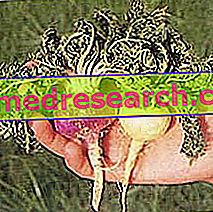Definition and nutritional properties
Offal are the internal organs and the (apparently) less valuable parts of the slaughtered animal.
The offal is part of the so-called "fifth quarter", that is, everything that does not fall within the "four quarters" of slaughter; the slaughtering quarters are 5:
- 2 front quarters
- 2 hind quarters
- 1 fifth quarter
The first four quarters divide the beast sagittally (obtaining 2 half-carcases) and transversely at the 6th coast. The fifth quarter includes the head, legs, tail and offal.

The most well-known offal are undoubtedly the liver and the heart; however, limiting the consumption of animal organs exclusively to these two pieces is extremely reductive. There are many offal and varying the consumption greatly enriches the nutritional intake of the diet; moreover, compared to the most common cuts of meat, the purchase of offal affects much less on the "health of the wallet!". In fact, on average, offal is a low-cost food, which allows the introduction of high biological value proteins, essential lipids, vitamins and mineral salts in abundance.
NB. In the case of hypercholesterolemia, it is better not to underestimate the intake of saturated fats and cholesterol contained in offal.
Types of offal
Among the offal we recall the "animelle", a term that generally indicates more organs of the calf or in any case of the bovine; these include the pancreas, the salivary glands but above all the "thymus", an endocrine gland positioned under the animal's neck (cholesterol 250mg / 100g of edible part).
The "brain" is a dish with an inebriating taste and the high percentage of lipids (among these very many phospho-lipids) gives it a typically melting consistency; the most consumed brain is that of the lamb, in the form of an "baked head", or that of the bovine consumed breaded and fried. (cholesterol> 2000mg / 100g)
The "heart" and the "liver" are the most common offal; they contain high levels of bio-available iron and the liver is an impressive vitamin source. The heart is generally cooked in a pan, thinly sliced with a little garlic and fresh parsley, while the most common recipe is "alla veneziana", with butter, flour and onion.
The "tongue" of the bovine falls, together with the "diaphragm", into the category of muscular offal. However, while the diaphragm lends itself very much to feeding the baby due to its tender consistency and good quantity of iron, the tongue has no particular nutritional characteristics and its consumption is substantially limited to the boiled meat mixture.
The "spleen" is the organ that makes the most iron ever, about 42 mg / 100g. Unlike the liver, the spleen is low in calories and contains a low percentage of lipids.
"Lung", "intestine" and "kidneys" (together with the liver and the heart), constitute the so-called "coratella"; this is nothing more than a set of carefully washed offal cooked in the pan together. It is a typical dish from central Italy, where lambs are slaughtered during the Easter period.
Finally, the "tripe". Contrary to what one might think, tripe is nothing more than the animal's stomach and its fat content is very small. The digestibility of this food is however scarce due to the very slow cooking and the high quantity of connective tissue containing collagen fibers.
Offal and health
Offal are excellent foods to be consumed on a weekly basis. It is however advisable to pay attention in the selection of the sources of supply and to prefer the Italian farms in which the disciplinary for the hormonal care and the veterinary controls are rigid and severely carried out; remember that offal are organs, and as such often suffer more toxic action and the storage of drugs and contaminants that may be present in feed.
offal | cholesterol [mg / 100g of food] * |
| Cooked beef sweetbreads | 466 |
| Cooked bovine brain | > 2000 |
| Heart of cooked beef | 274 |
| Cooked chicken heart | 231 |
| Cooked turkey heart | 238 |
| Cooked beef liver | 385 |
| Cooked liver liver | 746 |
| Cooked pork liver | 290 |
| Cooked turkey liver | 599 |
| Cooked beef tongue | 211 |
* maximum permitted average daily intake: 300 mg of cholesterol.



